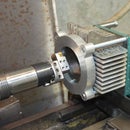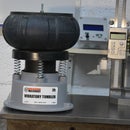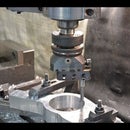Introduction: Tools for Reverse Engineering - More.
Perhaps the title should be "Cutting up calipers". Over the past few years cheap electronics have resulted in low priced measuring calipers and gauges of an accuracy good enough for many purposes. However there are times when standard instruments just will not fit where you want them. To many people cutting up a caliper is sacrilege but I view tools and measuring instruments as fair game if it helps utility.
This instructable illustrates some modifications that I have made to digital calipers and other instruments to serve particular needs. Some modifications are reversible but others are not. I have not listed materials or tools because that will be a function of each person's needs, but hopefully what is shown here will inspire others to take some ideas into their own arena.
All of the modified tools have been done to fill a need that I had, none were done just "because it seemed like a good idea". In most cases the photos show all that is necessary to understand and there will be minimal text.
Step 1: Shorty Digital Caliper
Sometimes off the shelf calipers are just too long to fit in some spaces. Cutting them shorter does NOT affect the reading. Remember that you have to cut off the depth gauge rod as well or that will add to the length when you open the caliper. I drilled a hole near the cut off end to take a small bolt as a stop to prevent running the slide off the end.
Step 2: Inside Only.
Continuing the theme of fitting into restricted spaces this caliper has the outside measuring jaws cut off. To date I have not done the reverse. That is to cut off the internal jaws. If I come across a real situation that needs that then I will do it.
Step 3: Jaw Surgery.
Unlike the previous steps this modification does not reduce the utility of the caliper at all. The external jaws have had their outer surfaces put on a diet to improve access in some situations.
Step 4: More Jaw Surgery.
This time the external jaws are relieved on the inner surface but leaving the original tips. The internal jaws are relieved on the outer faces. Both modifications are useful when lips or other shapes would prevent closing the jaws on to the desired area.
Step 5: Braking Calipers.
That is braking not breaking, no calipers were harmed.
A while back a local Lidl store had brake disc calipers on offer. Due to its long jaws it has been very useful for various purposes in standard form. Here you can see how I added to its utility by adding clamps to hold some threaded rod. This allows me to get very quick thickness measurements in awkward places.
Step 6: Additions to a Height Gauge - 1.
This applicable to both vernier and digital height gauges.
A simple rectangular bar fits normally onto the height gauge, the other end of the bar is drilled and tapped for a piece of 5 mm allthread. A 3 mm diameter piece of a carbide drill is pressed into a drilled hole in the rod. A grooved lock nut is made to made tightening by hand very easy.
A commercial offering is shown but that uses a clamping bolt on plain shaft instead of the threaded rod. I much prefer the threaded rod which is very stable when locked.
The main photo shows an example of use.
Step 7: Additions to a Height Gauge - 2
The addition of a dial or digital gauge to a height gauge is useful for many tasks. There are two principal benefits when this is an appropriate tool.
Firstly, the ability to set a zero, this is easier with a digital gauge. Of course you can do this with a digital height gauge also.
Secondly, when you are measuring surfaces that are not much different in height you can set the height gauge once rather than for each surface. This also applies to a digital height gauge. The 4 minute video shows just how useful this can be, Video link
Step 8: Additions to a Height Gauge - 3
I needed to measure the height of some holes off a surface plate. The usual measuring probe/scriber has a flat bottom and is about 6 mm wide. This is fine for measuring flat surfaces but is not suitable for narrow vertical slots or holes. Photos show a typical application which the stock measuring probe/scriber has trouble with.
I decided to stop my work and make a replacement measuring probe which I am sure will repay me many times over in time saved down the road. The next step shows it in the making.
The new probe block has some material underneath it which prevents the probe reading down to zero, the minimum is 3.5 mm but that is unlikely to be a problem for its intended and expected use.
Another way of doing the same job is to use a probe with a cone as the commercial offering in the last photo shows. This works OK when the entrance to the hole is in good condition, if the hole had been deburred by hand the edge may not be perfectly concentric with the hole and there are other possible "faults" which will affect the measurement with a cone.
Step 9: Making the New Probe.
My scrap box offered up a piece of 4140 which was hiding the piece that I needed, a broken 3 mm carbide drill bit completed the BOM. We can see the piece hiding in the block (never throw out even the most useless looking scrap).
This is the result of half an hour's marking and milling.
I wanted to position the bottom of the probe/stylus (I don't know what else to call it) such that it was the same distance down from the top reference surface as the original so that I could rely on the stock measuring scale. The original was 30 mm from the top surface to the underside of the scriber. To ensure this I initially drilled the hole centre, for the carbide drill bit, at 28.75 mm (30.25 - 1.5 = 28.75 mm. 1.5 is the stylus radius) down from the top surface. 30.25 mm instead of the final 30 mm to allow for any inaccuracy in positioning the hole. Then with the stylus pressed home I clamped the whole thing into the height gauge and used it to measure the height of a 10 mm gauge block. The vernier showed it to be 10.24 mm. I then milled another 0.24 mm off the top surface and retested. It was spot on as far as the vernier resolution could measure.
Step 10: Made for Piston Crowns.
Although I made this for measuring the thickness of piston crowns it is useful for some other measuring tasks on hidden surfaces. The steel pieces were from the scrap box as usual and that explains the stepped rocket shape of the two uprights.
Step 11: Thank You Santa.
The photo shows an ultrasonic thickness measuring instrument. Although I did not make this I include it here because of its utility for reverse engineering. Modern electronics allow such devices to be made available at affordable prices even for a home workshop. Not long ago such instruments would have cost thousands maybe tens of thousands. Santa's workshop turns these out for much less.
When it was first dropped down the chimney I was doubtful about how good it could be, but I have to say that I have been very impressed each time that I have used it. Of course it only gets used for those jobs that would be impossible or very difficult to do with my other available methods, then it is a life saver.
Dear Santa,
If I am a good boy, could you see your way clear to put a CMM on the sled this year?
Thanks in advance.
I hope that you found some ideas to take away from this Instructable, please make it a favourite and subscribe.











